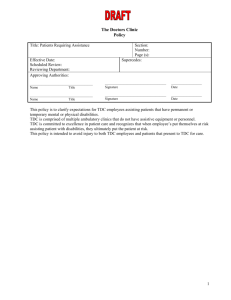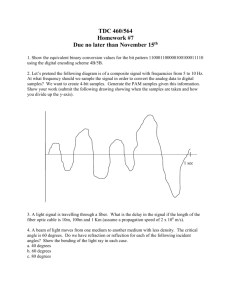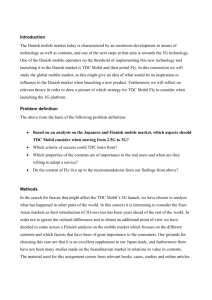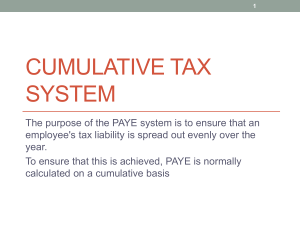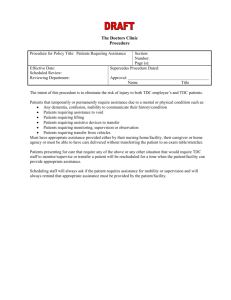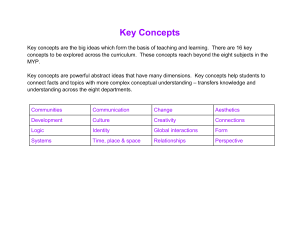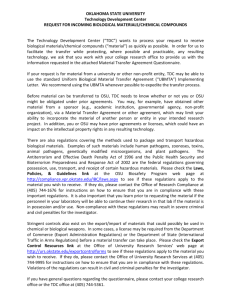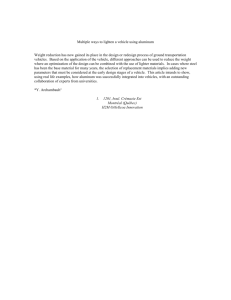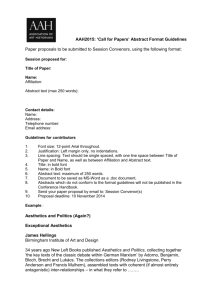The Total Design Concept - Institute for the Study of Business Markets
advertisement
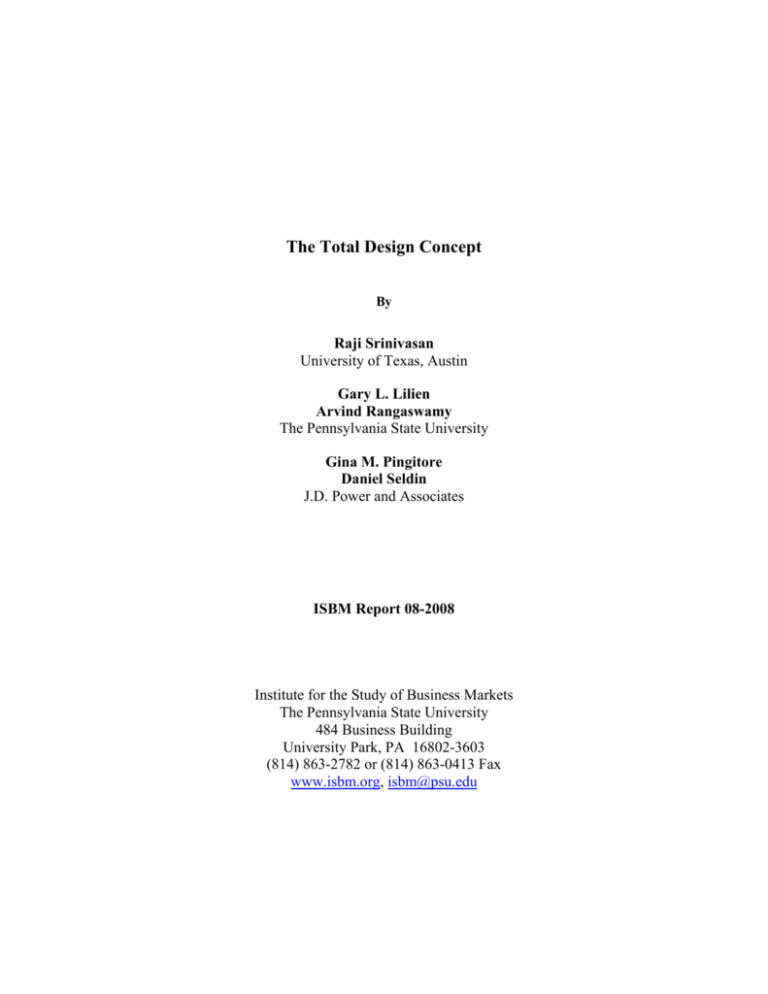
The Total Design Concept By Raji Srinivasan University of Texas, Austin Gary L. Lilien Arvind Rangaswamy The Pennsylvania State University Gina M. Pingitore Daniel Seldin J.D. Power and Associates ISBM Report 08-2008 Institute for the Study of Business Markets The Pennsylvania State University 484 Business Building University Park, PA 16802-3603 (814) 863-2782 or (814) 863-0413 Fax www.isbm.org, isbm@psu.edu THE TOTAL DESIGN CONCEPT Raji Srinivasan* Gary L. Lilien** Arvind Rangaswamy** Gina M. Pingitore*** Daniel Seldin*** December 2008 * Raji Srinivasan is Associate Professor at The University of Texas, Austin. ** Gary L. Lilien is Distinguished Research Professor of Management Science and Arvind Rangaswamy is the Anchel Professor of Marketing at The Pennsylvania State University. *** Gina Pingitore is Chief Research Officer and Dan Seldin is Senior Manager, Marketing Sciences, J.D. Power and Associates, 2625 Townsgate Road, Westlake Village CA 91361, United States Address correspondence to Raji Srinivasan, CBA 7.248, The University of Texas at Austin, TX 78712. Tel: 512-471-5441; Fax: 512-471-1034; Email: Raji.Srinivasan@mccombs.utexas.edu. The authors thank Abbie Griffin, Rajesh Chandy, Joann Peck, Christophe Van den Bulte, Robert Veryzer, Stefan Wuyts, and seminar participants at Arizona State University and at the Product Design Conference at University of Texas Austin in Fall 2007 for useful suggestions on the research. 1 THE TOTAL DESIGN CONCEPT ABSTRACT As traditional sources of competitive advantage shrink, firms seek new ones. One such source is product design. To generate insights on how product design can be leveraged to realize competitive advantage, we introduce an integrated, customer-experience perspective of product design that we call the Total Design Concept (TDC). We define a product’s TDC as consisting of three elements, functionality, aesthetics, and meaning, each of which are comprised of more elemental product characteristics. We develop the structure of the TDC, its three elements, and the link between those elements and customers’ perceptions of a product. We provide an illustrative application of the TDC in the US automotive industry. The findings support the proposed three dimensional view of the TDC, and demonstrate heterogeneity both in the TDC’s structure and its effects on customer experiences. The TDC and the supporting empirical findings generate implications both for research and for product design practice. Keywords: customer experience, product design, customer satisfaction, aesthetics, functionality, 1 INTRODUCTION Design can unlock the technological performance we build into a product and help the consumer see it, touch it. Good design is serious business. --- Alan G. Lafley, Chief Executive Office, Procter and Gamble, 2002. We keep reminding ourselves that almost every vehicle out there -- old, new, big, small, passenger cars, sports utility, roadster, minivan -- fulfills the basic transportation function, and they all fulfill it roughly equally well. Yet people go for the new. They go for the good-looking vehicle. That's why advanced product design is the core of our business strategy. --- Bob Lutz, Vice-Chairman, Daimler-Chrysler-Benz, 2002. Design DNA is all the rage as car makers try to make their vehicles stand for something --- Money magazine, Jan 13, 2006. For companies worldwide, design has become strategic, the very core of their efforts to differentiate what they make and do. ---- Business Week, July 10, 2006. As technological capabilities become more universally available, firms are exploring other venues when seeking a competitive advantage. One such venue is that of product design. Although both scholars (Kotler and Rath 1984; Venkatesh and Meamber 2006) and practitioners (Nussbaum 2006) have acknowledged the importance of design as a strategic marketing issue there is little in the marketing literature that aids in understanding the role of design in creating that competitive advantage. As the Marketing Science Institute (2003) noted “The relationship between marketing and design, and the marketing and design functions, is often complex. Both these aspects of product development play a critical role in determining the success or failure of new products, yet there is ample room for improvement in the role(s) design plays in new product development, in how marketing and design are integrated in new product development...” We introduce the Total Design Concept (TDC), an integrated, customerexperience based view of product design, to generate insights about how product design can be leveraged to realize competitive advantage. In what is generally regarded as a seminal idea in marketing, Levitt (1980) proposed the Total Product Concept’ (TPC) to include the generic product, the expected product, the 1 augmented product and the potential product. Urban and Hauser (1980) conceptualized their Product Design Concept (PDC) to include physical features and how those features are perceived by customers (relative to competitors). However, functionality, by itself, is not sufficient for successful differentiation in today’s increasingly competitive markets (Vogel, Cagan, and Boatwright 2005), and there have been calls for an integrated view of product design, as customers experience products holistically (Bloch 1995; Veryzer 1995). As Veryzer (1995; p. 642) noted, “it is important for consumer researchers to adopt a conceptualization of design that acknowledges the different aspects of product design (i.e., functional, communicative, and aesthetics)” a perspective we adopt in this paper. Some firms, like Harley Davidson Inc., have leveraged superior product design for competitive advantage. Consider the Harley Davidson’s Dyna Super Glide FDXI motorcycle (Figure 1) which has an easily replicable set of features (engine, fuel system, transmission etc). However, it has a unique, teardrop gas tank, oversized speedometer, and a hard tail which projects distinctive and aggressive visual aesthetics. The FDXI has a distinctive sound even when idling and the rev of its exhaust, according to some, sounds like “potato, potato”1 which reinforces its distinctive appearance. Beyond its functionality and aesthetics, the motorcycle projects the now-popular maverick American image, reflecting driving freedom for riders with a rebellious spirit. The market has rewarded Harley Davidson, which has focused on product design as a source of differentiation, with high customer satisfaction and loyalty, high resale value, and customers who appear content to wait for product delivery (Grant 2006). While the Harley example illustrates that a firm can extract rents from superior product design, such practice is far from common today. 1 Harley Davidson Inc. went so far as to file a trademark application for this characteristic sound in 1996. However, other firms filed oppositions to the filing of this trademark and the application was ultimately overturned. 2 ---- Insert Figure 1 here ---We propose an integrated representation of product design, which we term the Total Design Concept (TDC), consisting of three elements: (1) functionality, which arises from the product’s features and related benefits for customers, (2) aesthetics, comprising the product's sensorial characteristics, including, its appearance, touch, smell, taste and sound, and (3) meaning, involving the associations of the product in the minds of its customers. Further, we propose that a product’s various characteristics map onto to the TDC’s three design elements. In our proposed customer-centric view of product design, we suggest that customers may differ significantly both in how they map product characteristics onto the three design elements and in how those design elements affect customer experience. We proceed as follows. We first develop the TDC and relate it to extant ideas in the marketing literature. Then, we discuss the structure of the TDC’s design elements and their effects on customer experience. Next we demonstrate the validity of the proposed TDC, its design elements and their effects on customers’ experiences, using data on product ratings and customer satisfaction from 47,885 US vehicle owners. The empirical findings support the structure of the proposed TDC, the presence of customer heterogeneity in the mapping of product characteristics onto the design elements, and the differential effects of design elements on customer experience. We conclude with a discussion of the TDC’s implications for product management practice, marketing theory, and further research. THE TOTAL DESIGN CONCEPT (TDC) IN CONTEXT Scholars in several fields, including industrial design (Norman 2004), manufacturing (Hauser and Clausing 1988), production management (Krishnan and Ulrich 2001) and marketing (Levitt 1980; Urban and Hauser 1980) have explored issues related to product design. Not 3 surprisingly, the variance in goals and methods in the different areas has produced divergent definitions. For example, researchers in production and operations management define product design, as a process within the firm. Krishnan and Ulrich (2001, p. 9) define product design as “the detailed design phase which constitutes the specification of design parameters, precedence relations in product assembly, and the detailed design of the components including materials and process selection.” Marketing scholars (Levitt 1980; Urban and Hauser 1980 as noted earlier) have focused on product design, as a description of products’ characteristics. Adopting this approach, The Center for Universal Design at North Carolina State University (http://www.design.ncsu.edu/cud/about_ud/udprinciples.htm) has proposed seven principles of universal design to enable products and environments to be usable by all people to the greatest extent possible: equitable use, flexibility in use, simple and intuitive use, perceptible information, tolerance for error, low physical effort and size and space for approach and use. In this paper, like Urban and Hauser (1980), we use the term ‘product design’ to describe the product. The TDC Defined A fundamental premise in marketing is that a product’s functionality, resulting from its features, is a necessary, but not sufficient condition for effective differentiation. Experiential marketing scholars (Berry, Carbone and Haeckel 2002) suggest that both tangible and intangible product characteristics are intrinsic to the totality of what a product is. Accordingly, we propose that an accurate representation of the TDC includes, but is not limited to functionality. Second, because products are designed for customers, we integrate both firm and customer perspectives in the TDC. Third, Gestalt theorists in cognitive psychology argue that the mind perceives objects as being more than the sum of their parts (Koehler 1947). Thus, when we see three lines 4 and three angles, we see one entity, a triangle. Likewise, we propose that an integrated, holistic representation of product design is both essential and natural. The words of an industrial designer (Coates 2003) provide insight here: “it is impossible, in fact, to design a watch that tells only time. Knowing nothing more, the design of a watch alone—or of any product—can suggest assumptions about the age, gender and the outlook of the person who wears it.” Hinting at this holistic representation of product design, automotive industry executives refer to a vehicle’s “design DNA.” According to Mark Conforzi (2005), a Ford Motor Company designer, “When we talk about a car’s DNA, it’s not just about styling cues. DNA can include colors, trim names, performance feel, exhaust note, even the feelings, and the emotions a car evokes.” (p. 44). We note three properties of the proposed TDC. First, the unit of analysis is a specific product (e.g., Apple iPod, Logitech track ball mouse) and not the product category (e.g., multimedia players, mice). Second, we conceptualize the TDC’s three design elements as latent factors that specific product characteristics map onto. Third, the TDC merges the firm’s various activities beyond those specific to new product development activities. The TDC’s functionality arises from a product’s features which deliver the associated benefits to customers. The TDC’s aesthetics arise from the product’s sensorial characteristics, including its appearance, sound, touch, smell, and feel. Some (e.g., Santayana 1896) argue that beauty is an inherent property of objects and that certain proportions, shapes, and colors are universally attractive. However, there is widespread agreement now that socio-cultural factors (e.g., Berlyne 1971; Csikszentmihalyi and Robinson 1990) and individual characteristics (Bloch, Brunel, and Arnold 2003) influence customers’ aesthetic responses. Our conceptualization of aesthetics acknowledges the interaction between the product and the perceiver (or user) and thus 5 encompasses both the product’s objective properties and how those properties are perceived by customers. The TDC’s meaning is the associations of the product held by its customers. A product’s meaning is co-produced by the firm (through its product, marketing and communications programs) and its customers (through their interpretation of the product and its related marketing programs, and even its user community). A product’s meaning is specific to a market segment; it is not universal, since the concept is based on “me and my tribe” versus others which may include outside reference groups (Fournier 1998). We illustrate the TDC’s three design elements using Herman Miller’s Aeron Chair (Figure 2) (Vogel, Cagan, and Boatwright 2005). ---- Insert Figure 2 here ---Herman Miller Inc. introduced its Aeron office chair in 1994. The chair’s functionality is derived from several features that provide a superior seating experience. Dymetrol, the Du Pont’s synthetic material used in the Aeron chair’s back and seat pan, provides a breathable mesh interface between the user’s body and the chair. Its steel, gray frame creates a smooth transition from the open mesh to the frame, strongly supporting the user’s body and enabling the user to shift positions comfortably for different tasks. The Aeron chair’s spring-cushioned seat enables kinesthetic motion, lowering spinal compression and reducing chances of stress injuries. The Aeron chair’s dark gray frame and black open, woven synthetic material of its seat, which create an elegant, skeletal and yet a welcoming, comfortable look, create its aesthetics. The natural finish of its materials and its light, open design create a post-modern visual sensibility. The Aeron chair’s meaning shifts the traditional emphasis in organizations, on hierarchy, to users’ comfort. While most office chairs are designed based only on organizational hierarchy, with 6 senior managers getting larger chairs, Aeron chairs are offered in three sizes corresponding to the physical sizes of users, not to their organizational rank, creating the perception that the Aeron chair supports a flat, democratic organization. The TDC’s Relationship to Other Product Concepts The proposed TDC builds upon and extends two product concepts in the marketing literature—Levitt’s (1980) TPC and Urban and Hauser’s (1980) PDC (Table 1). ---- Insert Table 1 here ---As is evident in the title of Levitt’s paper “Marketing Success through Differentiation of Anything”, the basis of his Total Product Concept (TPC) was product differentiation to obtain competitive advantage in commoditized markets. The TPC includes the generic product, the expected product, the augmented product and the potential product. According to Levitt, the generic product is the rudimentary, substantive “thing” that motivates customers’ purchases. The expected product represents the minimal purchase conditions needed for customers to complete the purchase transaction. The augmented product refers to aspects that are beyond customers’ expectation and includes those aspects that can hold customers. Finally, the potential product includes everything that may be done to attract and hold customers, typically exceeding their expectations. Motivated to improve new product development processes, Urban and Hauser (1980, p. 155) define the Product Design Concept (PDC) “as the designation of key benefits the product is to provide, the psychological positioning of these benefits versus competitive products, and the fulfillment of the product promises by physical features.” Since the TDC decomposes the product concept into three design elements arising from the product’s characteristics, it is consistent with the TDC’s and the PDC’s multi-level product 7 representations. Like Levitt’s TPC, which identifies differentiation advantages when there is parity on the core product, the TDC identifies differentiation advantages where there is parity not only on core product functionality, but also on overall expected product functionality. Like Urban and Hauser’s PDC, the TDC incorporates the product’s marketing mix and competition explicitly through the meaning design element and implicitly through their effects on how customers structure their perceptions of the three design elements. However, the TDC goes beyond the TPC and PDC in several ways. First, the TPC and the PDC focus exclusively on functionality while the TDC incorporates aesthetics and meaning. Second, Levitt’s TPC, although not the PDC, has a hierarchical structure, where the generic product is embedded within the expected product, which is embedded within the augmented product, and which, in turn, is embedded within the potential product. The TDC’s structure imposes no such hierarchy and assumes no primacy of any design element. Third, the TPC and the PDC have been developed from the product perspective, and are independent of the product’s customers, which preclude them from accommodating customer heterogeneity. In contrast, the TDC integrates product and customer perspectives, a theme we develop below. CONCEPTUAL FRAMEWORK Following the discussion above, we propose a conceptual framework that provides a structure for the TDC and then relates it to customer experience (Figure 3). Note that the framework incorporates heterogeneity across customers in the mapping of product characteristics on the three design elements, and in their effects on customer experience. ---- Insert Figure 3 here ---Product Characteristics and Design Elements 8 Accounting for heterogeneity in customers’ tastes, needs, and preferences has long been fundamental tenet in marketing (e.g., Frank, Massey and Wind 1972), requiring firms to develop distinctive products, and associated marketing strategies to serve the diverse needs of customers. Consider, for example, that Toyota Motor Corporation sells numerous brands and models within brands (e.g. Lexus LS460, Lexus IS 250, Camry, and Scion xA), each of which has different product characteristics. These differently designed products with different marketing program induce heterogeneous customer responses, including in their search (Beatty and Smith 1987; Punj and Stewart), and information processing (Bettman, Johnson and Payne 1991; Richins and Bloch 1992) of products. These arguments suggest that we should expect heterogeneity in the customer-experience based mapping of product characteristics to the TDC’s three design elements. Design Elements and Customer Experience Customer experiences arise from their comparisons of the rewards and costs of the purchase (Oliver 1980). In particular, the product’s functionality is positively related to customer satisfaction (Churchill and Surprenant 1982), an overall effect we expect through our conceptualization. In addition, customers differ in their responses to products and those differences should extend to the design domain. Customers’ responses to products vary by their personal relations to products (Richins and Dawson 1992), visual versus verbal processing abilities (Houston, Childers, and Heckler 1987), cognitive innovativeness (Venkatraman and Price 1990) and need for uniqueness (Snyder and Fromkin 1980). With respect to aesthetics, Bloch, Brunel and Arnold (2003) report individual differences in the centrality of visual product aesthetics (CVPA) which they defined as the level of 9 significance that visual aesthetics holds for a particular customer in his/her relationships with product. Creusen and Schoormans (2005) found that the influence of a product’s appearance (e.g., shape, color and size) on customers’ assessment of product value varied significantly across customers. Finally, a product’s meaning, which is both imbued in it by the firm and is also coproduced by the product’s customers, varies different customer communities that define themselves in relation to a focal product (e.g. Kozinets 2001; Schouten and McAlexander 1995). Thus, a given product may have multiple meanings created through several interpretive communities, so that the effects of meaning on customers’ responses to the product are heterogeneous across customers (Fournier 1998). Integrating these ideas suggests that the effects of a product’s three design elements on customer experience will vary across customers. EMPIRICIAL ILLUSTRATION IN THE US AUTO MARKET Exploring the proposed TDC with data from managerial practice would be useful in establishing its validity. However, the richness of the TDC framework does not permit holistic testing with readily available data. Hence, we seek an environment where we can identify data that corresponds, roughly, to our conceptual framework and enables us to evaluate the face validity of that framework. Consistent with the TDC’s customer-based perspective, we seek customers’ ratings of a product and their experiences with it. We obtained access to one such source: customer experience data collected by J.D. Power and Associates (JDPA) in their Vehicle Quality Survey (VQS) in the US automotive market. The VQS includes customers’ ratings of vehicles’ product characteristics and their satisfaction with the vehicles, within 90 days of their purchase of a new vehicle. We use customer satisfaction in the VQS data to represent customer experience. 10 The Data The VQS data we used for this analysis covered vehicle 47,885 owners in 2006, including 15 corporations (e.g., American Honda Motor Company, Volkswagen of America, Inc.), 35 makes (e.g., Acura, Honda, Subaru) and 263 make-models (e.g., Nissan Xterra, Buick Lacrosse). See Appendices A1 and A2 for an overview of the VQS methodology and the associated measures respectively. The VQS measures that ask customers to rate the vehicle’s tangible product characteristics (e.g., fuel efficiency), intangible product characteristics (e.g., appearance) and communicative aspects (e.g., ruggedness, prestige), correspond roughly to functionality, aesthetics and meaning respectively and, are therefore, consistent with our conceptualization. Given the very large number of product characteristics (over 60) in the VQS survey, the JDPA methodology (details in Appendix A1), aggregates ratings using product sub-categories (e.g., exterior and interior corresponding to aesthetics) to simplify interpretation. We adopt these subcategories in our analyses. Thus, we mapped the following sub-categories of product characteristics onto the functionality design element (Appendix A2): 1. Storage and space: storage and space usage, ease of getting in and out of the vehicle, leg and head room, storage spaces in the vehicle and in the trunk area. 2. Driving dynamics: driving dynamics including ride smoothness, responsiveness of steering and braking system, handling and stability. 3. Fuel efficiency: fuel economy and the driving range between stops. 4. Engineering/transmission: engineering and transmission including the performance during rapid acceleration from stop, passing power at high speed and smoothness of gear shift operations. 5. Safety: visibility and driving safety including visibility from driver’s seat, effectiveness of headlights, ease of controls, displays while driving. 6. Seating: Seat belt comfort and adjustability, flexibility of seat configurations, and quality of seating materials. 11 7. Heating, ventilation, air conditioning: heating and air conditioning including ability to maintain desired temperature, controls and ability to defrost/defog the interior glass. 8. Audio system: overall quality of audio system including sound clarity, ease of controls and quality of sound including bass and impression of surround sound. We mapped the following two sub-categories of product characteristics onto the aesthetics design element: 1. Exterior: the vehicle’s exterior’s attractiveness including the styling of the front, side and rear profiles, appearance of paint and wheels, and sound of doors when closing. 2. Interior: the vehicle’s interior’s attractiveness including the attractiveness of the instrument panel and dashboard, look and feel of steering wheel, ability to rest arms, and smell of vehicle interior. For the meaning design element, we used data on seven characteristics of the vehicle’s image (see Appendix A2). To reduce dimensionality, we used factor analysis and identified two factors using the eigenvalue criterion (Eigen value > 1), which we identified as prestige and ruggedness. VQS measures Customer Satisfaction with the vehicle as the owners’ overall rating of the vehicle on a 10-point scale (mean = 8.24 standard deviation = 1.63). Results Three-Factor Structure of TDC. We examine the appropriateness of the proposed TDC’s 3-element conceptualization by estimating alternative confirmatory factor models.2 First, we estimated a one-factor model where all product characteristics load onto a single design element, which in turn affects customer satisfaction. We then estimated three two-factor models: (1) where the functionality- and aesthetics- related product characteristics load onto one factor and the meaning-related product characteristics map into a second, and (2) where the aestheticsrelated and meaning-related product characteristics load onto one factor and the functionality- 2 For identification purposes, one product characteristic for each design element (storage for functionality, exterior for aesthetics and prestige for meaning) is set equal to 1. 12 related product characteristics map into a second factor, and (3) where the functionality-related and meaning-related product characteristics map onto one factor, and aesthetics-related product characteristics map onto the second factor. Finally, we estimated a 3-factor model where the functionality-related product characteristics map onto the first factor, the aesthetics-related characteristics map onto the second factor, and the meaning-related characteristics map onto the third factor.3 The three-factor model outperformed the other models on the Bayesian Information Criterion (BIC). All of the factor loadings for the product characteristics on to the three design elements were positive and statistically significant (p < .01). The factor correlations between the three design elements are as follows: (ρ (functionality, aesthetics) = .556; ρ (aesthetics, meaning) = .434; and ρ (functionality, meaning) = .289) supporting the TDC’s holistic conceptualization with the three design elements of functionality, aesthetics, and meaning. The TDC’s Structure and its Effects on Customer Satisfaction. We then applied our conceptual framework to the automobile data by developing and estimating a structural model that relates product characteristics to the three product design elements (latent factors), that, in turn, are related to customer satisfaction. We included two control variables (the number of problems encountered and the vehicle’s price) and four customer demographics (age, gender, household income and education) in the model relating the TDC’s design elements to customer satisfaction. We permit heterogeneity by using a finite mixture structural equation modeling approach (Jedidi, Jagpal, and DeSarbo 1997) that directly identifies latent segments on the basis of inferred relationships between customer satisfaction and the underlying three latent factors. 3 Due to multicollinearity of ratings of product characteristics, all of which are provided by one respondent, we were unable to estimate a model where all the product characteristics directly influenced customer satisfaction. 13 We control for dependencies across observations of a given vehicle using a random effects formulation at the make-model level. See Appendix A3 for an outline of the estimation approach. We also include nine psychographic factors to profile the latent segments: four factors pertaining to customers’ preferences in buying a vehicle (distinctiveness, economy and safety, conservativeness, and American centricity) and five factors pertaining to their choice of vehicle (comfort, reliability, large vehicle, environmental consciousness, and value consciousness. We estimated the model in Mplus 4.2 software. The 3-segment model (entropy = .934) outperformed the models with 1, 2, and 4 segments based on the Bayesian Information Criterion. Segment 1 has 34,329 respondents (72% of the population), Segment 2 has 12,121 respondents (25%), and Segment 3 has 1,434 respondents (3%). We provide the results of the 3-segment, structural equation model in Table 2. Overall, the results support heterogeneity in the mapping of the product characteristics on to the three design elements (Factor Model: Stage 1) and in the effects of the three design elements on customer satisfaction (Path Model: Stage 2), which we next discuss in detail. ---- Insert Table 2 here ---The Mapping of Product Characteristics in Defining the Design Elements (Stage 1). Based on Wald tests of the parameter estimates of the relative loadings of product characteristics on the design elements, for customers in Segment 1 (Column 2 of Table 2), the vehicle’s storage and space, driving dynamics, engineering transmission, safety, seating, air-conditioning and audio system mapped on more strongly to the functionality design element than its fuel efficiency (all at p < .01). The vehicle’s interior features loaded more strongly onto the aesthetics design element than did its exterior features (p <.01), whereas the vehicle’s prestige mapped more strongly on to the meaning design element than did its ruggedness (p < .01). 14 For customers in Segment 2 (Column 2 of Table 2), the vehicle’s storage and space, driving dynamics, engineering transmission, safety, seating, air-conditioning, and audio system, mapped more strongly on to functionality than its fuel efficiency (p <.01). With respect to aesthetics, the vehicle’s interior loaded more strongly onto the aesthetics design element than the vehicle’s exterior ( p <.01), while the vehicle’s ruggedness mapped more strongly on to the meaning design element than its prestige ( p <.01). For customers in Segment 3 (Column 3 of Table 2), the vehicle’s driving dynamics, fuel efficiency, engineering transmission, safety, seating, air-conditioning, and audio system, mapped more strongly on to functionality than its storage and space (p < .01). With respect to aesthetics, the vehicle’s interior again more strongly loaded onto aesthetics than on to its exterior (p <.01), while the vehicle’s ruggedness mapped more strongly on to meaning than its prestige (p <.01). Integrating the mapping results across the three segments suggests differences in the effects of various product characteristics on functionality, aesthetics, and meaning across customers in the three segments. The Effects of Design Elements on Customer Satisfaction (Stage 2). With respect to the effects of design elements on customer satisfaction, functionality is the most important design element for customers in Segment 1(b = 0.488, p < .01 compared to b = 0.301, p < .01 for aesthetics and b = 0.189, p <.01 for meaning), which are all significantly different from each other at p <.01. Meaning is the most important design element for customers in Segment 2 (b = 1.509 compared to b = 0.974 for functionality and b = -0.424 for aesthetics) and for customers in Segment 3 (b = 0.545 compared to b = 0.260 for functionality and b = 0.212 for aesthetics). We discuss the negative coefficient for the effect of aesthetics for customers in Segment 2 below, when we integrate these results with the profiles of the three segments. 15 Profiling the Three Segments. Next, we integrate the segment profiles with the factor loading model and regression results (Table 3). Customers in Segment 1 (72%), have average incomes, and were generally satisfied with their vehicles (mean = 8.76) and had experienced the fewest problems with their vehicles (mean = 1.01). These customers seek reliable, non-American vehicles. The APEAL Index score of vehicles in this segment was 821(average APEAL Index score in 2006= 769) the highest across the three segments. ---- Insert Table 3 here ---With respect to the links between the three design elements and customer satisfaction, aesthetics is positively related to customer satisfaction for customers in Segment 1. However, the effects of functionality are higher than the effects of aesthetics (p < .01) and meaning (p <.01) on customer satisfaction, implying that for this largest segment of vehicle owners, the vehicle’s functionality is more important than its aesthetics or meaning in influencing customer satisfaction. Customers in Segment 2 (25%), who had low incomes, were less satisfied with their vehicles (mean rating = 6.69 on a 10-point scale) and reported the most number of problems with their vehicles (mean = 2.22). These customers seek American vehicles with low prices, which may, post facto, explain their low customer satisfaction with their vehicles. The J.D. Power and Associates APEAL Index score for their vehicle was 654 and is the lowest across the three segments. The negative effect of the vehicle’s aesthetics on customer satisfaction in Segment 2 is surprising. Post-hoc, we conjecture that those customers who were interested in a vehicle’s low price may have been disappointed with their vehicle’s performance, and may have inferred that the manufacturer wasted money on frills (aesthetics) at the expense of its functionality. 16 Customers in Segment 3 (3%), who also had low incomes, were very satisfied with their vehicles (mean rating = 9.33 on a 10-point scale), although they experienced some problems (mean=1.18) with their vehicles. These customers were seeking cars “that stand out from the crowd.” These customers were very satisfied with their vehicles even though the APEAL Index scores of vehicles in this segment is average (mean=761 compared to overall average of 769). Robustness Checks. We tested the robustness and sensitivity of our results to the specific sample of customers and products. To do so, we first randomly removed 10% of the data and re-estimated the model; following that procedure we obtained results generally consistent with those reported in Table 2. Next, as there are several small and expensive brands that could be outliers and might have an effect on the structure of our results. Hence, we eliminated those brands (Porsche, Volvo and BMW) from the data set and re-estimated the model, and again obtained results generally consistent with those reported in Table 2. Summary of Empirical Illustration Overall, the results of this empirical illustration in the US automotive industry provide encouraging, albeit preliminary, support for the TDC framework: our test of the dimensionality of the framework supports the existence of three design elements, our demonstration of the three (latent) segment solution for the structure demonstrates customer heterogeneity in the mapping of product characteristics on to the three design elements as well as in their differential effects on customer satisfaction. DISCUSSION Despite the growing importance of product design as a source of competitive advantage in business practice, there are few insights in the marketing literature relating product design to 17 customers’ experiences. We developed a general and integrative framework to understand the role and effects of product design that could be applied in different industries. In our framework various product characteristics help define three core design elements, namely, functionality, aesthetics, and meaning. In turn, these design elements influence customers’ satisfaction with a product. The empirical application of the TDC the auto industry supported its three-design element conceptualization, and heterogeneity in its structure and effects on customer satisfaction. Theoretical Contributions An expanded view of product design to include functionality, aesthetics and meaning. We propose that product design encompasses functionality, aesthetics, and meaning, which together constitute the product’s TDC, thus extending past conceptualizations of product design (Levitt’s TPC and Urban and Hauser’s PDC), which have focused only on functionality. Moreover, our empirical findings in the US automotive industry support the TDC’s three-design element structure over alternative structures. The TDC framework provides a more flexible representation of design elements than the hierarchical frameworks proposed in the past. Thus, our research represents a contribution toward developing an integrative framework for product design that can be applied in a range of settings An expanded view of product design to include the firm, customers and competition. In a departure from past research, which has conceptualized product design primarily from a firm’s perspective, our framework is customer-centric. Our expanded conceptualization suggests that the firm’s marketing mix strategy (e.g., pricing, communications) is a key aspect of product design as is the product’s competitive positioning, both being embodied in the design element that we termed as meaning. Given the increasingly dynamic nature of customers and 18 competition, an implication of our work is that a product’s TDC is fluid and evolving and that firms should view themselves, at best, as co-owners of the product design process. Explicit incorporation of customer heterogeneity in product design. Some customer segments place a greater emphasis on a product’s meaning, other segments on a product’s aesthetics, and yet others emphasize a product’s functionality. Even the importance of various product characteristics (e.g., seat belt adjustability and comfort) in defining a design element (e.g., functionality) varies across segments. Nevertheless, the existence of well-defined segments suggests opportunities for companies to target specific segments even during the early stages of the new product development process. Managerial Implications Product design encompasses functionality, aesthetics and meaning and thus involves both the firm’s new product developers and marketers. In most firms, each of the TDC elements is developed, owned, and managed by a different organizational unit or function. A product’s functionality may be the engineering function’s domain, while aesthetics belongs to the industrial design function, and meaning is managed by the marketing function and advertising agency. Moreover, the three design elements are often developed at different times in the product’s evolution: the development of a product’s functionality and aesthetics typically preceding the development of its meaning. The integrated TDC underlines the need for firms to coordinate the design process across functions to effectively manage their products’ design and enhance customers’ responses to their products. Our review of the business press indicates that while some firms (e.g., Apple Inc., Hermann Miller Inc., Oxo Inc.) emphasize all three design elements in developing products, most do not, focusing primarily on their products’ functionality. Hence, we perceive an 19 opportunity for firms to look beyond functionality in their products and consider adding industrial designers to their product design teams to incorporate a holistic, TDC-based approach to product development and management. Product design involves customers, and is sometimes a co-creation of the firm and its customers. The customer-based perspective that we adopt in developing the TDC suggests that product design emerges from the firm’s product development efforts and marketing activities (i.e., packaging, advertising, distribution, etc.) and the tastes, preferences, and actions of its customers. This perspective underscores the importance of recognizing customer heterogeneity in product design, and its effects on customers’ evaluations of products. The important role of customers in the creation of product’s total design, suggests both opportunities and constraints for firms in the design and management of products. Firms must actively engage their customers in the development and management of products, which should potentially increase the sources of differentiation and design innovation rents for firms relative to when they are excluded from this process. However, with such an engagement results in a loss of control: because customers are actively engaged in the co-production of a product’s design, especially the meaning element, the firm is inherently ceding some control of product design to its customers. And given the dynamic nature of the TDC, marketing research related to TDC cannot be a project undertaken at a particular time, but must be ongoing because of the dynamics of the technological, competitive and customer-taste landscapes. Product design as a source of innovation rents. The TDC suggests that in addition to functionality, a product’s aesthetics and meaning, differentiate a firm’s offerings, and influence customer satisfaction, hence providing opportunities for appropriation of economic rents via design decisions. In addition, unlike differentiation based on functionality, differentiation based 20 on the aesthetic or meaning design elements is less imitable by competitors, as such differentiation is stickier than functionality. For example, while other multimedia players share the Apple iPod’s functionality, the iPod’s distinctive design, combining its outstanding functionality with aesthetics and meaning, is resistant to competitive imitation, increasing revenues, price premiums, and customer loyalty (Business Week, March 21, 2005). Thus, the proposed TDC approach, with the inclusion of aesthetics and meaning, may be a useful blueprint for the developing products in commoditized markets, characterized by parity in functionality, that appeal to customers and generate superior rents and/or create higher barriers to imitation. Opportunities for Research The TDC provides a new conceptual lens to view the processes that underlie customers’ responses to products. A question that emerges is whether the nature of customers’ responses to the three design elements is different. For example, does functionality produce cognitive responses, while aesthetics and meaning produce affective responses? Or do the TDC’s elements blend together to produce an integrated customer response? The available data do not permit us to address these questions. Future research that examines the inter-relationships among the design elements and the inter-play of cognitive and affective responses on customers’ responses to products will be useful. An interesting question is whether the effects of the TDC’s design elements change with customers’ experiences with the product. For example, does the domain of the design elements (i.e. the mapping of the different product characteristics onto the design elements) differ when customers initially choose a product versus after they have used the product for some time? Customer panels with data that includes data prior to, during, and post-product purchase of other products would be useful for undertaking such a program of research. 21 An integrated approach to new product management processes that is suggested by our research may have significant implications for a product’s market performance: What is the nature and magnitude of performance reward for a product developed using a TDC approach? Are the rewards for a TDC approach different across product categories, or across segments in a product category, or across firms, or over time for a given product? Are some organizational or product management team characteristics more or less likely to result in a TDC approach to product development? Another interesting question is how the various marketing mix elements (e.g., price, promotion, and place) affect the rewards accruing to a TDC approach to product design. One might also ask, what are the benefits of a firm’s integrated TDC approach for new product development on various performance outcomes, including sales growth, profitability, and shareholder value (Griffin and Page 1996)? And, how do these benefits differ across industries or across firms in a given industry? We have developed the TDC in the context of physical goods. Does the TDC also apply to services, and, if so, how? Exclusive country clubs and living communities are two examples of services where many of these concepts may apply directly. We perceive an opportunity to integrate the TDC with the idea of “total customer experience” (Berry, Carbone, and Haeckel 2002) for the design and management of services. The richness of the TDC structure does not readily permit holistic testing with existing ‘real-world’ data and will likely require customized data collection. The data collected by J.D. Power and Associates via the Vehicle Quality Survey (VQS) in the US automotive market provided us an opportunity to illustration our proposed TDC framework. However, because the VQS data have been collected for a different purpose (i.e. rating the performance of vehicles), the data do not contain measures that have a one-to-one correspondence with our framework, 22 especially for the meaning design element. Future research that explores the TDC with customdesign methods to more accurately capture the three design elements in other product categories and relates them to different outcome variables will be insightful. On net, we hope that we have contributed in some way to product design theory, and that the proposed TDC approach is helpful for managers to develop strategies that leverage their products’ designs to enhance their customers’ experiences. 23 REFERENCES Beatty, Sharon E. and Scott M. Smith (1987), “External Search Effort: An Investigation across Several Product Categories,” Journal of Consumer Research, 14 (1), 83-95. Berlyne, D.E. (1971). Form and Psychobiology. New York, NY: Appleton-Century-Crofts. Berry, Leonard L., Lewis P. Carbone, and Stephan H. Haeckel (2002), “Managing the Total Customer Experience,” MIT Sloan Management Review, 43 (3), 85-89. Bettman, J. R., E. J. Johnson, and J. W. Payne (1991), “Consumer Decision Making,” 50-84, in Handbook of Consumer Behavior. T.S. Robertson, and H.H. Kassarjian, eds. Upper Saddle River, NJ: Prentice Hall. Bloch, Peter H. (1995), “Seeking the Ideal Form: Product Design and Consumer Response,” Journal of Marketing, 59 (3), 16-29. Bloch, Peter H., Frédéric F. Brunel, and Todd J. Arnold (2003), “Individual Differences in the Centrality of Visual Product Form: Concept and Measurement,” Journal of Consumer Research, 29 (March), 551-565. Business Week, March 25, 2005 “Online Extra: Commentary: Apple’s Blueprint for Genius (accessed June 3, 2006) [available at http://www.businessweek.com/print/magazine/content/05_12/b3925608.htm]. Churchill, Gilbert A., Jr. and Carol Surprenant (1982), “An Investigation into the Determinants of Customer Satisfaction,” Journal of Marketing Research, 19 (4), 491-504. Coates, Del (2003), Watches Tell More Than Time: Product Design, Information and the Quest for Excellence. New York, New York: McGraw-Hill. Conforzi, Mark (2005), “Looking for an Edge in your Business,” Design Does Matter, (3), 4445. Creusen, Mariëlle E. H., and Jan P. L. Schoormans (2005), “The Different Roles of Product Appearance in Consumer Choice,” Journal of Product Innovation Management, 22 (1), 63-81. Csikszentmihalyi, M., and R. E. Robinson. (1990). The Art of Seeing: An Interpretation of the Aesthetic Encounter. Los Angeles, CA: The J. Paul Getty Museum and The Getty Education Institute for the Arts. Fournier, Susan (1998), “Consumers and their Brands: Developing Relationship Theory in Consumer Research,” Journal of Consumer Research, 24 (4), 343-73. Frank, R. E., W. F. Massey, and Y. Wind (1972). Market Segmentation. Englewood Cliffs, NJ: Prentice-Hall. Grant, Robert M. (2006). Contemporary Strategy Analysis. Fifth edition, Boston, MA: Blackwell Publishing Inc. Griffin, Abbie, and Albert L. Page (1996), “The PDMA Success Measurement Project: Recommended Measures for Product Development Success and Failure,” Journal of Product Innovation Management, 13(5), 478-496. 24 Hauser, John R. and Don Clausing (1988), “The House of Quality,” Harvard Business Review, 66(3), (May-June), 63-73. Houston, Michael J., Terry L. Childers, and Susan E. Heckler (1987), “Picture-Word Consistency and the Elaborative Processing of Advertisements,” Journal of Marketing Research, 24 (November): 359-69. Jedidi, Kamel, Harsharanjeet S. Jagpal, and Wayne S. DeSarbo (1997), “Finite-Mixture Structural Equation Models for Response-Based Segmentation and Unobserved Heterogeneity,” Marketing Science, 16 (1), 39-59. Koehler, Wolfgang (1947). Gestalt Psychology: An Introduction to New Concepts in Modern Psychology. New York, NY: Liveright Publication Corporation. Kotler, P. and Rath, G.A. (1984), “Design a Powerful but Neglected Strategic Tool”, Journal of Business Strategy, 5(2), 16-21. Kozinets, Robert V. (2002), “Can Consumers Escape the Market? Emancipatory Illuminations from “Burning Man”, Journal of Consumer Research, 29 (1), 20-38. Krishnan, V., and Karl T. Ulrich (2001), “Product Development Decisions: A Review of the Literature,” Management Science, 47 (1), 1-21. Lafley, A.G. (2004), “Delivering Delight” Fast Talk, 83(June), 51. Levitt, Theodore (1980), “Marketing Success through Differentiation —of Anything,” Harvard Business Review, 58(1), 83-91. Lutz, Bob (2002), “Chrysler’s Robert A. Lutz on Design, @issue journal, 3(2), (accessed June 1, 2006) [available at http://www.cdf.org/journal/0302_lutz.php] Money Magazine (2006), “New Cars Strive for Bolder Looks” (accessed June 13, 2006) [available at http://money.cnn.com/2006/01/13/Autos/funonwheels/detroit_design_language/index.ht m]. Muthen, Bengt (2002), “Beyond Structural Equation Modeling,” Behaviormetrika, 29(1), 81117. Norman, Donald A. (2004), Emotional Design: Why We Love (or Hate) Everyday Things. New York, New York: Basic Books. Nussbaum, Bruce (2006), “The Best Product Design of 2006”, Business Week, July 10, 2006, 3992, 74-78. Oliver, Richard L. (1980), “A Cognitive Model of the Antecedents and Consequences of Satisfaction Decisions,” Journal of Marketing Research, 17 (4), 460-69. Punj, Girish N. and David W. Stewart (1983), “An Interaction Framework of Consumer Decision Making,” Journal of Consumer Research, 10 (2), 181-96. Richins, and Peter H. Bloch (1986), “After the New Wears Off: The Temporal Context of Product Involvement,” Journal of Consumer Research, 13 (3), 280-285. 25 Richins, Marsha L. and Scott Dawson (1992), “A Consumer Values Orientation for Materialism and Its Measurement: Scale Development and Validation,” Journal of Consumer Research, 19 (3), 303-16. Santayana, George (1896). Sense of Beauty. New York, NY: Charles Scribner Sons. Snyder, C.R., and H.L. Fromkin (1980). Uniqueness: The Human Pursuit of Difference. New York, NY: Plenum Press. Urban, Glen L., and John R. Hauser (1980), Design and Marketing of New Products. Englewood Cliffs; NJ: Prentice-Hall. Venkatesh, Alladi and Laurie A. Meamber (2006), “Arts and Aesthetics: Marketing and Cultural Production,” Marketing Theory, 6(1), 11-39. Venkatraman, Meera, and Linda Price (1990), “Differentiating between Cognitive and Sensory Innovativeness: Concepts, Measurement and Implications,” Journal of Business Research, 20, 293-315. Veryzer, Robert W. (1995), “The Place of Product Design and Aesthetics in Consumer Research, Advances in Consumer Research, 22(1), 641-645. Leigh McAlister and Michael Rothschild, eds. Provo; UT. Vogel, Craig M., Jonathan Cagan, and Peter Boatwright (2005), Design of Things to Come, The: How Ordinary People Create Extraordinary Products. Philadelphia, PA: Wharton School Publishing. 26 APPENDIX A1 J.D. Power and Associates Customer Satisfaction Index Methodology The J.D. Power and Associates Automotive Performance, Execution and Layout (APEAL) SM Index is an industry benchmark for measuring the appeal of new vehicles and owner satisfaction and is derived using data from the VQS study. The overall index score measures how much customers like or dislike virtually every aspect of their new vehicle, with the objective of helping vehicle manufacturers identify specific design aspects of the vehicle on which they should focus their efforts. The VQS study covers 95 characteristics covering power train, exterior and interior design, seats, audio/entertainment/ navigation, and convenience features. The J.D. Power and Associates index models assume that the attribute variables predicting overall satisfaction are grouped into sub-categories. These categories were determined based on both J.D. Power and Associates industry-related knowledge of what produces customer satisfaction with new vehicles during the first 90 days of ownership. Factor analysis was used in the early stages of the development of the Index to determine how the characteristics should be grouped into categories and to eliminate items that had a poor fit within the subcategory or were redundant with other items. Based on this technique, the VQS Index Model is based on 10 subcategories. The 10 subcategories are: Storage and space, Driving dynamics, Fuel efficiency, Engineering/transmission, Seating, Safety, Heating, ventilation, air conditioning, and Audio system, Exterior and Interior. In the Index Model, each subcategory includes an overall rating item for that category. Further, the questionnaire is organized so that all items within a category are grouped together and are followed by the overall rating item for that category. For example, the overall rating in the Engine/transmission subcategory, respondents are asked with one question, “Overall rating of the vehicle’s engine/transmission.” At the individual attribute level, the model contains more detailed information related to specific engine and transmission characteristics, such as “Performance during rapid acceleration from a stop.” 27 APPENDIX A2 Measures: Vehicle Quality Survey (VQS) Construct (Mean; standard deviation) Customer Experience Customer Satisfaction (mean = 8.24, standard deviation (sd) = 1.63) Functionality Storage and space (mean = 7.61, sd = 1.73) Driving dynamics (mean = 7.98, sd = 1.68) Fuel efficiency (mean = 6.72, sd = 2.18) Engineering/transmission (mean = 7.80, sd = 1.80) Safety (mean = 7.78, sd = 1.66) Seating (mean = 7.64; sd = 1.63) Heating, ventilation and air conditioning (mean = 7.74, sd = 1.73) Audio system (mean = 7.64, sd = 1.81) Aesthetics Interior (mean = 7.94, sd = 1.66) Exterior (mean = 8.18, sd = 1.57) Meaning Prestige (factor score) (semantic differential scale 1- 5) Ruggedness (factor score) (semantic differential scale 1- 5) Profiling Variables for Latent Segments Motivations to buy vehicle (factor score – 5 factors from 11 items) Preferences for vehicles (factor score – 4 factors from 11 items) Domain of items Overall satisfaction with your new vehicle Ease of getting in and out of the vehicle, leg and head room, storage spaces in the vehicle and in the trunk area Ride smoothness, responsiveness of steering and braking system, handling and stability. Fuel economy and the driving range between stops Performance during rapid acceleration from stop, passing power at high speed and smoothness of gear shift operations. Visibility from driver’s seat, effectiveness of headlights, ease of controls, displays while driving. Seat belt comfort and adjustability, flexibility of seat configurations, and quality of seating materials. Ability to maintain desired temperature, controls and ability to defrost/defog the interior glass. Sound clarity, ease of controls and quality of sound including bass and impression of surround sound The instrument panel and dashboard, look and feel of steering wheel, ability to rest arms, smell of vehicle interior. The styling of the front, side and rear profiles, appearance of paint and wheels, and sound of doors when closing. Elegant – unrefined (.88); Innovative – conventional (.61) Stands out - blends in (.56) Luxurious - no frills (.92) Prestigious – common (.91) Rugged – fragile (.81) Reliable – unreliable (.74) Comfort, reliability, large vehicle, environmental consciousness and value consciousness. Distinctiveness, safety, conservativeness, and American-centric. 28 APPENDIX A3 Outline of Finite Mixture Structural Equation Model Modeling Framework Let s index membership in a (unknown) segment (s = 1, ….S) and s denote a (3 1) vector of exogenous latent variables (the three design elements of functionality, aesthetics and meaning). Let x|s denote a (p 1) vector of observable indicator variables measuring s . x and y are indexed by customers i for a given makemodel m, which we suppress to simplify notation. Then, following Jedidi, Jagpal, and DeSarbo (1997), we can specify the measurement model for the exogenous latent variable s as follows: x | s xs sx s s Where sx (A3.1) is a (p n) is a coefficient matrix of factor loadings, x is a (p 1) vector of the s s is the vector of measurement error in x | s . Let measurement intercept terms, and E ( s ) s , E[( s s )( s s )' ] s , E ( s s ' ) s . We assume that E ( s ) 0, and that the vectors of measurement errors are uncorrelated with the vector of latent variables. Although our measurement model includes two constructs, each measured with just two indicators, the measurement model is nevertheless identified because we allow all the constructs to be correlated Our structural model defines the hypothesized relationship of customers’ satisfaction with their car (the dependent variable) and the exogenous latent variables (the three design elements) and several control variables (z), defined as: y | s, z s ( s )' s ( s )' z s s Where (A3.2) s is a (3 1) vector of parameters that specify the relationship between the exogenous latent variables and y in segment s, and s is a (r 1) vector of parameters that specify the relationship between r observed control variables and y in segment s, s is the intercept term, and s is the error term specified in more detail below. To specify the mixture component of the structural equation model given in A3.1 and A3.2, let s be the prior probability of an observation belonging to latent class or market segment s (or, equivalently, s is the segment S proportion in the population). s 1 s 1 and 0 s 1 . In what follows, we have suppressed the notation i to represent the customer. We assume that the density of y, f(y|, w, ), is a mixture of S class-specific densities, fs(y|s). That is: 29 S f ( y | w, ) s ( w) f s ( s ) (A3.3) s 1 where w denotes a set of profiling variables for each customer, and denotes all unknown parameters of the measurement and structural models, and s is the subset of the unknown parameters that apply to segment s. We assume fs(.) to be multivariate normal with 0 mean, i.e., s is N(0, s). We allow the correlations between the three latent constructs of functionality, aesthetics and meaning to be non-zero. Estimation We estimate the finite mixture SEM model using MPlus software (Version 4.2). The software models s as a logit. Specifically: r s sj j s j 1 e S (A3.4) r s sj j e j 1 s 1 For identification, we set 1 = 0. The covariates (z) in our case include the customers’ preferences for vehicles and customers’ motivations to buy this vehicle (Appendix A2). Parameter estimates are obtained by maximizing likelihood via the EM algorithm (Muthen 2002). To determine the number of latent segments, we use the Bayesian Information Criterion (BIC) (Schwarz 1978) to compare the model with s segments with a model with s+1 segments s = 1, 2, … until the model fit stops improving. BIC is calculated as: BIC 2 * LL P * ln( N ) where LL, P, and N stand for loglikelihood value, number of parameters, and sample size respectively. We also report an entropy measure of I separation (ES), the extent of separation of the segments which is calculated as ES 1 S p i 1 s 1 is ln( pis ) N ln(S ) (A3.5) where pis is the posterior probability of customer i belonging to segment s, which is calculated using the Bayes rule. ES is bounded in the range 0 to 1, such that a value closer to 1 indicates good separation of the latent segments. 30 TABLE 1 TDC AND OTHER PRODUCT DESIGN CONCEPTS Variables Total Product Concept (TPC) (Levitt 1980) Product Design Concept (PDC) (Urban and Hauser 1980) Total Design Concept (TDC) Motivation for construct Basis for differentiation in markets commoditized on functionality. Identify product’s core benefit proposition to improve product development processes. Basis for differentiation in markets commoditized not only on TPC’s generic product, but also on potential product. Definition TPC includes generic, expected, augmented and potential products. Product design is the designation of key benefits it provides, the psychological positioning of these benefits versus competitive products, and the fulfillment of the product promised by its physical features (1980, p. 155) TDC consists of three design elements: (1) functionality, which arises from the product’s features and related benefits for consumers, (2) aesthetics, its sensorial characteristics, including, sight, touch, smell, taste and sound, and (3) meaning, the associations of the product held by consumers. Structure Focus only on functionality. Focus only on functionality. Focus on functionality, aesthetics, and aesthetics. Hierarchy Hierarchical; generic product followed by expected, augmented and potential products. Non-hierarchical among the product’s various physical features. Non-hierarchical among the three design elements. Competition Excluded. Included through positioning of benefits. Included through the meaning design element Centricity Monocentric; product perspective Monocentric; product perspective Dual-centric: Integrates product and customer perspectives. The TDC’s locus is the consumer, whose evaluations constitute the TDC. Customer heterogeneity No Indirectly (through needs identification for customer segments) Given the TDC’s locus of customers, it accommodates customer heterogeneity. 31 TABLE 2 TWO-STAGE MODEL OF PRODUCT CHARACTERISTICS, TDC’S DESIGN ELEMENTS AND CUSTOMER SATISFACTION (N=47, 885) Variable Aggregate Segment 1 Segment 2 Segment 3 Column 1 Column 2 Column 3 Column 4 1.000 1.060*** .937*** 1.066*** 1.055** 1.016*** 1.061*** 1.062*** 1.000 .980*** .920*** 1.001*** 1.010*** .986*** 1.017** 1.059*** 1.000 1.166*** .947*** 1.146*** 1.111*** 1.040*** 1.105*** 1.094*** 1.000 1.415*** 1.267*** 1.452*** 1.374*** 1.447*** 1.527*** 1.558*** 1.000 1.154*** 1.000 1.092*** 1.000 1.241*** 1.000 1.890*** 1.000 .745*** 1.000 0.548*** 1.000 1.004*** 1.000 3.736*** .548*** .336*** .286*** .488*** .301*** .189*** .974*** -.424*** 1.509*** .260*** .212*** .545*** -.070*** -.001 (ns) .000 (ns) -.001 (ns) -.015 (ns) .004 (ns) -.017*** -.001* .002* -.002*** .002 (ns) .029*** -.068*** -.001*** -.004* -.005*** .017 (ns) -.028 (ns) -.024*** .000 (ns) -.015*** .000 (ns) -.114*** -.151*** - 34,329 (.72) 12,121 (.25) 1,434 (.03) Mapping of Product Characteristics on Design Elements (Stage 1) (loadings) Functionality Storage and space Driving dynamics Fuel efficiency Engineering transmission Safety Seating Heating, ventilation and air conditioning Audio system Aesthetics Exterior Interior Meaning Prestige Ruggedness Satisfaction: Effects of Design Elements (Stage 2) Functionality Aesthetics Meaning Control Variables Problems Encountered Vehicle Price ($) Income Age Gender Education Segment Size Entropy of separation for 3-segment model 0.934 32 TABLE 3 TDC AND CUSTOMER SATISFACTION Profile Size Segment 1 Segment 3 Very few (3%) Chevrolet HHR, Dodge Honda CRV, Hyundai Sonata, Scion xB How satisfied are they with their vehicle? Problems with their vehicle APEAL Index (mean score=769) Income Moderate (8.76) One-fourth of customers (25%) Chevrolet Cobalt, Chrysler Town and Country, Dodge Dakota, Hyundai Elantra Not at all (6.69) 1.01 2.22 1.18 821 654 761 Average Low Low What they look for in vehicles? Reliable, non-American vehicles American, value priced vehicles Meaning, large vehicles What are some exemplar vehicles in this segment? Majority (72%) Acura TL, Audi A4 Sedan, Cadillac CTS, Segment 1 Very (9.33) 33 FIGURE 1 HARLEY DAVIDSON DYNA SUPER GLIDE FDXI Functionality: Engine: air-cooled twin cam 88® V-twin, displacement: 1450cc, bore and stroke: 95.18 mm X 101.52 mm Fuel system: Electronic Sequential Port Fuel Injection (ESPFI), Compression Ratio: 8.9:1 Fuel efficiency: 50 hwy mpg/ 44 city mpg Transmission: six-speed Aesthetics: Crackpin Trademark V-twin engine Distinctive tear-drop gas tank Oversized speedometer Classic, hard tail bike look Unique engine “potato potato” sound (even idling) and exhaust sound Market response High customer satisfaction and loyalty Waiting period for motorcycle High resale value Meaning: American icon Unique rebellious, recreational lifestyle 34 FIGURE 2 ILLUSTRATING THE TDC: HERMAN MILLER’S AERON CHAIR Functionality Synthetic, breathable weave of Dymetrol for greater comfort. Metal frame and adjustable hand rest strongly supports body. Controls to move chair easily placed All features aimed to increase comfort and lower workrelated injuries. Aesthetics Transparent weave of seat pan and backrest provides light, simple look. Frame in dark gray provides elegant, skeletal look. Meaning Different size chairs based on size of person, not hierarchy – supporting a flat, horizontal organization The informal, sleek look emphasizes individual comfort over conformity and rigidity associated with work-life, in general and other office furniture, more particularly. 35 FIGURE 3 CONCEPTUAL FRAMEWORK: TDC AND CUSTOMER EXPERIENCE Ratings of Product Features Ratings of Product Features Ratings of Product Features Heterogeneity in the mapping of the product characteristics on to the three design elements Functionality Customer Experience Aesthetics Meaning Heterogeneity in the effects of the three design elements on customer satisfaction 36
